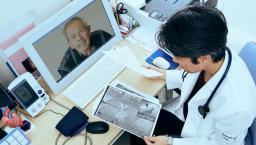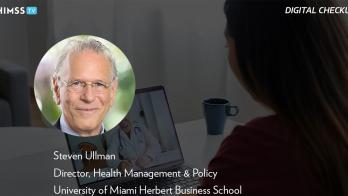A light bulb went off: 'Alexa for telemedicine!'

David A. Higginson, executive vice president and chief innovation officer at Phoenix Children's Hospital
Photo: Phoenix Children's Hospital
As was the case with many healthcare organizations, the COVID-19 pandemic ushered in a significant increase in telehealth visits for Phoenix Children’s Hospital – especially in outpatient clinics.
THE PROBLEM
For a children’s hospital, this meant that often for the first time, parents and/or extended family could attend a doctor’s visit virtually and take a more active role in the care of their children.
As the pandemic trailed off, many families said while they knew they needed to attend future visits in person, they wished the other family members, who had to return to work, could still be part of the care team.
At the same time, like many provider organizations, Phoenix Children’s, which has a long history of IT innovation, was struggling to find people to work in clinical support roles such as interpreters, social workers and nutritionists – and the few people the organization did have in these roles were spread thin, spending almost 40% of their day walking between clinics.
"Since the pandemic made 'hybrid' meetings more common, we asked ourselves, How do we create a 'hybrid' style visit where the doctor and the patient are in-person but others can be brought in virtually and even on-demand?" said David A. Higginson, executive vice president and chief innovation officer at Phoenix Children's Hospital.
"The first challenge was finding a screen, microphone and speaker that could run Zoom seamlessly and reliably so we could add the technology to every exam room," he continued. "With more than 750 exam rooms at the organization, we certainly couldn’t have delays in care because the AV staff was running around troubleshooting issues."
At the same time, the price point had to be significantly lower than a PC or an iPad on a stand if the hospital was going to have the devices always ready to go and available in every room, he added.
"So, the challenge was set: We needed to develop and figure out a way to fund a hands-free, telehealth-capable device in 750 exam rooms with no new FTEs to support it," he explained.
PROPOSAL
One night when thinking about the problem and ruling out almost every option he could think of, Higginson was interrupted with a voice: "From Amazon, one new package arriving for David tomorrow."
"I glanced up at the Alexa Show in my living room and the idea struck me – we could use an Alexa device," he revealed. "They never crash, never need manual updating, are inexpensive and I recently recalled seeing an article saying Alexa would be supporting Zoom, Phoenix Children’s telehealth partner.
"The next day I dug into the Zoom feature and set up the device to join a test telehealth session," he said. "We then searched for anyone else who may have been doing the same thing to see if the devices could stand up to daily use and be managed in a healthcare environment. As it turned out, Amazon had just launched an initiative called Alexa Smart Properties and they were looking for early adopters to build out the product."
Fortunately for Phoenix Children’s, it has a program where donors provide funding to try new and innovative pilot programs. They funded the first clinic with Alexa, so the provider organization was able to quickly start working toward turning this idea into reality.
MARKETPLACE
There are many vendors of telemedicine technology and services on the health IT market today. Healthcare IT News published a special report highlighting many of these vendors with detailed descriptions of their products. Click here to read the special report.
MEETING THE CHALLENGE
The first use case with the Alexa technology was to provide a mechanism for family members to join the in-person visit. It was immediately very popular.
"We built the integration so the provider or medical assistant could initiate the secure meeting on Alexa with the press of a single button from their EHR dashboard and send an invite to the remote parent or caregiver," Higginson explained. "This allowed ad-hoc hybrid visits with limited fuss and preparation.
"We quickly realized we could extend the system to bring various support people to the visit and built out the integration that allowed our internal interpreters to provide services via Zoom versus walking back and forth between clinics," he continued. "The next step was to add in our interpretation vendor, Cyracom, as they supported Zoom meetings."
This provided physicians with the capability to simply select the language they needed in the EHR and request an interpreter. As a result, all the complexity happens behind the scenes, and within 60 seconds an interpreter is on the Amazon Show.
"More recently we incorporated an electronic behavioral health screening in many of our clinics, which, under certain criteria, requires us to refer the patient to a behavioral health therapist for immediate evaluation," he said. "After the patient’s original visit occurs, the physician does a warm handoff to the therapist using the Alexa Show in the clinic room, and the therapist conducts an evaluation and education session with the patient before they leave.
"This just-in-time, virtual care has provided countless children with access to a therapist when they would normally be waiting for weeks and could be at risk," he continued.
Finally, with several new ERs opening away from the main hospital campus, the devices have been used among ER physicians to consult with the hospitalist prior to admission. It also allows the hospitalist to see and talk to the patient as needed – allowing a more accurate and coordinated admission to the hospital.
RESULTS
With any new technology like this, the key metric for success is adoption, Higginson said.
"Would these devices sit in the corner collecting dust, or would they be embraced by the caregivers and patients?" he continued. "I’m happy to report that all 70 clinics at Phoenix Children’s use the devices daily for the use cases above and furthermore have started to find new uses by themselves – always a testament that something is well-adopted.
"Just recently, we had a provider unexpectedly out sick who was scheduled to oversee a patient with a reaction to a food allergy," Higginson noted. "Due to quick thinking by the team, the provider was able to provide clinical guidance using the Alexa Show in coordination with the support team and patient in the room."
Staff also regularly use the devices to entertain and educate families with video and music to help pass the time when they are waiting in the clinic room for the provider.
"Six months following implementation, we have more than 75 daily sessions using the Alexa Show devices, no additional FTEs needed to support them, and an increase in interpreter productivity by more than 20%," he added.
ADVICE FOR OTHERS
Telehealth and remote work are two areas that changed vastly during the pandemic and continue to evolve.
"We all are more open to innovative ways to remove physical boundaries from care delivery using techniques that are new, and sometimes a little scary or unusual," Higginson said. "Rather than always jumping to iPads on stands that must be wheeled around or full PCs in each room, give some thought to other technologies you use in everyday life that work, are familiar and might solve a difficult problem.
"If you can adopt these technologies, you might be surprised at all the ways you can use them that were not part of your original use case," he concluded.
Follow Bill's HIT coverage on LinkedIn: Bill Siwicki
Email him: bsiwicki@himss.org
Healthcare IT News is a HIMSS Media publication.
























